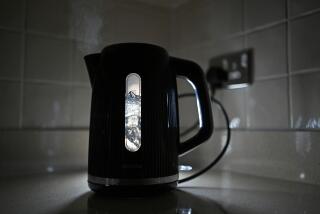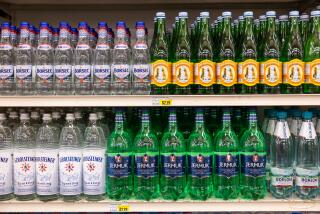CONSUMERS : Water . . . Where? : What Will You Drink in Case of Emergency? With Planning, There Will Be Plenty
Californians who don’t have adequate emergency water supplies at home should take a lesson from Yucca Valley residents.
Just hours after the 7.5 Landers earthquake June 28, many desert residents were desperate for drinking water. They bought out bottled supplies from stores, then besieged distributors and Red Cross chapters with requests for emergency drinking water.
In some cases, residents’ municipal water supplies were cut off; others had broken water pipes in their homes that polluted the water and made it undrinkable.
Dale LaForest, preparedness director of the Los Angeles Chapter of the American Red Cross, recommends that residents store a minimum of one-half gallon of water per person per day for drinking and have at least a three-day supply.
The exact quantity of water needed for drinking each day depends on the size of the person, the amount of exertion or activity, weather and perspiration loss.
Additional water will be needed for pets, brushing teeth, bathing and dishwashing. But even keeping a three-day supply may not be enough, experts say.
“The feeling is that the vast majority of utilities will be restored within 72 hours,” LaForest says. “But in a catastrophic earthquake, there certainly will be areas without water for longer than that. After the Loma Prieta quake, people were trucking in water a long time because their wells went dry. An earthquake changes the water tables and it doesn’t take much to make wells go dry.”
Commercially bottled water can be purchased at supermarkets or mass merchandising outlets or from bottled water companies, such as Sparkletts or Arrowhead.
Costing $7 to $8 each, the five-gallon containers that are delivered to homes and offices by bottled water companies are made of heavier plastic than the 1- and 2 1/2-gallon jugs, and will last longer if their seals aren’t broken. The smaller sizes have a more limited shelf life and should be checked for leaks and rotated once a year.
All stored water supplies should be dated and kept in a cool dark place away from chemicals, which possibly could pass through the plastic.
Stored bottled water also can develop a slight plastic taste over an extended period of time, but that will not effect the quality.
Sparkletts technical services coordinator Sarah Cowman says the 3- and 5-gallon water bottles can last up to 20 years without cracking. “I would not have any concern about putting them in the garage and expecting them to last 10 to 20 years,” she says.
Sparkletts only delivers 3- and 5-gallon containers of water to its regular residential and commercial customers. It will, however, deliver an earthquake preparedness kit--12 one-gallon bottles of water, an emergency candle and an emergency safety stove ($19.50 plus tax)--to non-regular customers.
Arrowhead will make one-time deliveries. But, according a company spokeswoman, “we can’t always accommodate customers immediately.”
Water also is available commercially in 4-ounce aluminum packages, 8.45-ounce boxes with straws and 12-ounce aluminum cans, all with a 5-year shelf life.
You also can store tap water in containers at home. Experts recommend using heavy opaque plastic jugs with screw-on tops or stackable plastic-lined cardboard cubes with spigots. Plastic juice and soft drink bottles also can be used, but tend to crack more easily. After filling, seal and date them.
Tap water treated only with liquid chlorine bleach should be replaced every six months. However, if you use a commercial water treatment product--sodium hypochlorite with a bactericide--you can extend the shelf life of water to five years.
Some drugstores sell water treatment solutions, as do companies such as the Earthquake Preparedness Society in Santa Fe Springs. It offers Water Preserver Concentrate in several sizes, and also sells 2.45-gallon water cube boxes ($7.50) in which you can store tap water. Thirty- and 55-gallon drums are also available. (Call (800) 628-9111.)
Other sources of water in the home include: water drained from the hot water heater, if it remains upright after the earthquake; water remaining in the plumbing--after you have turned off the valve leading to your home from the water main, and water dipped from the flush tank of a toilet.
Melted ice cubes are another source: a standard 14-cube tray of ice will yield two cups of water. And liquid from canned fruit also can be drained and drunk. A 1-pound, 13-ounce can of peaches, for example, will provide about 1 1/2 cups of liquid.
If your water is polluted, strain it through paper towels, paper coffee filters or several layers of clean cloth into a clean container to remove any sediment or floating matter. Boil vigorously for 10 minutes.
If you are unable to boil the water, strain it and add liquid chlorine bleach or 2% tincture of iodine to purify it for immediate use. (See table.)
You should keep an eyedropper for adding bleach or iodine in your earthquake preparedness kit. Mix chlorine bleach or iodine thoroughly by stirring or shaking water in container, and let stand for 30 minutes before using.
Liquid chlorine bleach loses strength over time. If bleach is a year old, double the amount. Do not use bleach that is two years old, and do not use granular household bleach, which is poisonous.
Water purification tablets, available in drug and sporting goods stores, have a shelf life of two years and will lose their effectiveness if allowed to get damp. Follow directions for number of tablets needed; in most cases, four tablets will purify one quart of water.
For free earthquake preparedness pamphlets contact:
* Los Angeles Department of Water and Power, (800) DIAL-DWP.
* Los Angeles Chapter of American Red Cross, (213) 739-5200.
* Los Angeles City Fire Department, (213) 485-PREP.
Where to Find Water at Home
* Shut off the water valve leading from the water main to the building. Wheel turns clockwise.
* In case of leaks outside the home, use a crescent wrench to turn off the curb valve located at the water meter between the meter and the curb.
* Bottled water stored in a cool, dry place. Minimum needed for drinking is two quarts per day for each person in the family. Don’t forget that pets also will need water.
* Water drained from hot water heater, if it remains upright. To drain: turn off gas/electric supply. Close inlet water valve. Open any hot water faucet or disconnect water line at the top of the tank. Drain water into container from faucet at bottom of the heater.
* You can use the water that remains in the plumbing. If your home is a two-story one, you can drain water in the pipes by gravity flow after water is shut off at the outside valve. Open a faucet on the top floor and drain water from a faucet at lowest level.
* Upstairs and downstairs: You can use water dipped from the flush tank of toilets (not the bowl), but you should purify it before drinking.
* Other inside water sources: melted ice cubes, liquid from canned fruit or vegetables.
* Do not drink water that is used in a water bed because the plastic may release chemicals into it.
* Do not drink water from swimming pools or spas. You can use it for hygiene purposes, but drinking it could cause diarrhea because of over-chlorination or permanent kidney damage because of the high level of salts that can accumulate.
Purifying Water
Amount of Amount of chlorine Amount of tincture of water bleach to add to: iodine 2% to add to: clear cloudy clear cloudy water water water water 1 quart 2 drops 4 drops 3 drops 6 drops 1 gallon 8 drops 16 drops 12 drops 24 drops 5 gallons 1/2 teaspoon 1 tsp. 3/4 tsp. 1-1/2 tsps.
(Purchase an eyedropper for adding bleach or iodine. Keep it for this purpose only)
Source: Lafferty & Associates, Inc.
More to Read
Sign up for Essential California
The most important California stories and recommendations in your inbox every morning.
You may occasionally receive promotional content from the Los Angeles Times.










